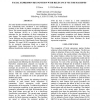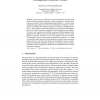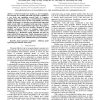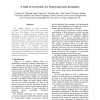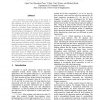FGR
2002
IEEE
14 years 4 months ago
2002
IEEE
We present ongoing work on a project for automatic recognition of spontaneous facial actions. Spontaneous facial expressions differ substantially from posed expressions, similar t...
DAGM
2003
Springer
14 years 4 months ago
2003
Springer
A new direction in improving modern dialogue systems is to make a human-machine dialogue more similar to a human-human dialogue. This can be done by adding more input modalities, e...
ICMCS
2005
IEEE
14 years 5 months ago
2005
IEEE
For many decades automatic facial expression recognition has scientifically been considered a real challenging problem in the fields of pattern recognition or robotic vision. The ...
AMFG
2005
IEEE
14 years 5 months ago
2005
IEEE
We present a new framework to represent and analyze dynamic facial motions using a decomposable generative model. In this paper, we consider facial expressions which lie on a one d...
IROS
2006
IEEE
14 years 5 months ago
2006
IEEE
— In the last decade, face analysis, e.g. face recognition, face detection, face tracking and facial expression recognition, is a very lively and expanding research field. As com...
IBPRIA
2007
Springer
14 years 5 months ago
2007
Springer
The recognition of emotional information is a key step toward giving computers the ability to interact more naturally and intelligently with people. This paper presents a completel...
ICMCS
2007
IEEE
14 years 5 months ago
2007
IEEE
In this paper, we propose a new approach of facial expression recognition. In order to capture the temporal characteristic of facial expressions, we design dynamic haar-like featu...
ICPR
2008
IEEE
14 years 5 months ago
2008
IEEE
The existing methods of facial expression recognition are typically based on the near-frontal face data. The analysis of non-frontal-view facial expression is a largely unexplored...
ICASSP
2008
IEEE
14 years 5 months ago
2008
IEEE
In this paper, we present a novel approach for 3D facial expression recognition which is inspired by the advances of ant colony and particle swarm optimization (ACO and PSO respec...
FGR
2008
IEEE
14 years 5 months ago
2008
IEEE
Face information processing relies on the quality of data resource. From the data modality point of view, a face database can be 2D or 3D, and static or dynamic. From the task poi...

